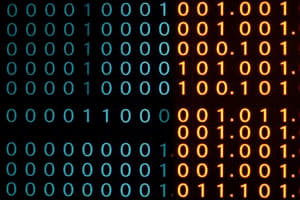Podcast
Questions and Answers
When converting binary numbers to octal, how many bits are grouped together?
When converting binary numbers to octal, how many bits are grouped together?
- 4
- 2
- 3 (correct)
- 5
What is the base of the octal number system?
What is the base of the octal number system?
- 10
- 16
- 2
- 8 (correct)
In binary to octal conversion, how would you represent the binary number 1010?
In binary to octal conversion, how would you represent the binary number 1010?
- 5 (correct)
- 10
- A
- 12
When converting hexadecimal to binary, what does each hexadecimal digit represent?
When converting hexadecimal to binary, what does each hexadecimal digit represent?
What is the equivalent of the octal digit '7' in binary?
What is the equivalent of the octal digit '7' in binary?
In the octal system, what symbol is used to represent the highest value?
In the octal system, what symbol is used to represent the highest value?
What symbols are used in the binary number system?
What symbols are used in the binary number system?
How are binary numbers represented?
How are binary numbers represented?
What distinguishes a hexadecimal number system from a binary number system?
What distinguishes a hexadecimal number system from a binary number system?
How are hexadecimal numbers formed?
How are hexadecimal numbers formed?
What is the most significant bit in a binary number?
What is the most significant bit in a binary number?
What is the role of digital number systems in computing?
What is the role of digital number systems in computing?
Flashcards are hidden until you start studying
Study Notes
Exploring Digital Number Systems
In the realm of computing and data representation, digital number systems play a fundamental role. These systems are based on a finite set of symbols, and they form the foundation for everything from coding to arithmetic operations in digital devices. In this article, we'll delve into three primary digital number systems: binary, hexadecimal, and octal, and discuss how to convert between them.
Binary Numbers
At the heart of modern digital technology lies the binary number system, which uses only two symbols: 0 and 1. This system is directly related to the operation of electronic circuits, as transistors can be in one of two states—on or off, which can be associated with the symbols 1 and 0, respectively.
A binary number is represented as a series of bits, like this:
10101
In this example, the bits are read from right to left, with the rightmost bit being the least significant and the leftmost bit being the most significant.
Hexadecimal Numbers
While binary numbers are easily processed by computers, it's often useful to represent them in a more human-friendly format; this is where the hexadecimal number system comes in. In this system, a set of 16 symbols are used: the 10 digits 0–9 and the six letters A–F. Hexadecimal numbers are formed by grouping binary bits into sets of four.
10101
↓
B
In this example, the binary number 10101 is converted to the hexadecimal number B.
Octal Numbers
Another alternative to binary is the octal number system, which uses a base of eight. In this system, the symbols range from 0 to 7. Octal numbers are formed by grouping binary bits into sets of three.
10101
↓
5
In this example, the binary number 10101 is converted to the octal number 5.
Converting Between Number Systems
Converting numbers between binary, hexadecimal, and octal systems is relatively straightforward. Here's a high-level overview of the conversion process:
-
Binary to Hexadecimal:
- Convert binary bits to hexadecimal by grouping bits into sets of four (left-most fill with 0).
- Replace each block of four with its corresponding hexadecimal digit.
-
Binary to Octal:
- Convert binary bits to octal by grouping bits into sets of three (left-most fill with 0).
- Replace each block of three with its corresponding octal digit.
-
Hexadecimal to Binary:
- Replace each hexadecimal digit with its equivalent block of four binary bits (0 represents 0, 1 represents 1, A represents 10, and so on).
-
Octal to Binary:
- Replace each octal digit with its equivalent block of three binary bits (0 represents 0, 1 represents 1, 2 represents 10, and so on).
-
Hexadecimal to Octal:
- Convert each hexadecimal nibble (a pair of bits) to its corresponding octal digit.
-
Octal to Hexadecimal:
- Convert each octal digit to its equivalent nibble (a pair of bits).
With practice, these conversions become second nature, and they're crucial for understanding and working with digital number systems in computer science and engineering.
Conclusion
Understanding digital number systems such as binary, hexadecimal, and octal is essential for anyone interested in the inner workings of computers and digital devices. By applying the conversion techniques outlined in this article, you'll be able to work with these systems and gain a deeper understanding of the fundamentals behind digital computing. Happy learning!
Studying That Suits You
Use AI to generate personalized quizzes and flashcards to suit your learning preferences.




